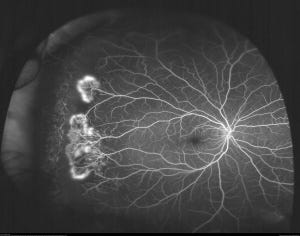They say the eyes are the windows to the soul—
but what if sickle cell disease is drawing the curtains?
Today, we’re going to explore how sickle cell disease can affect sight and what steps can be taken.
Ready?
Now, not everyone reading this has sickle cell disease, the trait, or even know someone that has sickle cell disease.
But that shouldn’t stop you for trying to get to understand the condition and how it appears. It is already widely underrepresented and talked about among the masses. So let’s take the 3 mins to get to understand it.
We will take it step-by-step.
Before we get to the eyes specifically, let’s start here.
Quick genetics lesson on Sickle Cell Disease
Sickle cell Disease (SCD) is one of a group of inherited disorders that affect the shape of red blood cells (RBCs) (the cute circular red discs) that carry oxygen to all parts of the body.
RBSs are usually round and flexible so they can easily move around to where they’re needed. But in SCD the RBCs are shaped as sickles or moon shaped, making them rigid and sticky which slows their movement in vessels and can block blood flow.
Alright now.
So there is different types of SCD.
Here is a breakdown:
Here’s a visual representation:
Capisce?
Or capeesh?
Whichever one; potayto, potahto.
To the eyes.
Now that we have an idea on SCD and the different alleles, we can speak sickle cell retinopathy (SCR), where the same abnormally shaped red blood cells obstruct tiny blood vessels in the retina (the layer in back wall inside the eye).
Remember how I mentioned sickle cells can block vessels? Well naturally your body tries to fight back by trying to create more vessels. Only thing is that the new blood vessels are more fragile, and in severe cases, can lead to retinal detachment (the retina, pulls away from its usual position), potentially resulting in vision loss if untreated.
Studies indicate that proliferative sickle cell retinopathy (PSR) affects up to 40% of individuals with HbSC genotype (SCD milder form) and 20% with HbSS genotype (SCD severe form).

So are you at risk?
Probably not.
Unless you have sickle cell disease or sickle cell trait. Notably, the prevalence of SCR is higher in certain genotypes; for instance, the Jamaican Cohort Study reported a 43% prevalence in HbSC (SCD milder form) and 14% in HbSS (SCD severe form) by age 20.5 years.
What is looks like
SCR can progress through stages:
Early: Often asymptomatic (you can’t tell), making regular eye examinations crucial.
Advanced: Symptoms may include floaters, blurred vision, or dark spots.
Severe: Retinal detachment can occur, leading to significant vision loss.
Takeaway this
Get checked early and often:
Regular eye exams are essential for early detection and management of SCR, even in the absence of symptoms. Not just for SCR but for any other eye disease that could be manifesting silently.Know your genotype:
Understanding whether you have sickle cell disease or trait is vital. And if you know yours, get someone else to find theirs out too.
Liked it? share it! 🖤
The content in this publication is intended for informational and advocacy purposes only. It is not formal medical advice. If you have concerns about your eye health or need medical guidance, please consult your healthcare professional.






